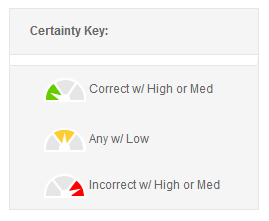Learner Certainty Assessment: Proving Training Works (Part2)
In part one of this two-part article, we discussed learner certainty as an assessment technique that provides more realistic training measurement benefiting both administrators and learners. Let's continue the discussion now with further details on how this type of training assessment works and some ideas for implementation.

How it Works
Is your current knowledge assessment strategy effective?
Yes NoHow certain are you in your answer?
Unsure Somewhat Certain Totally CertainLearner Certainty Assessment (LCA) offers a unique engagement opportunity during a training assessment. Much like the two questions shown above, a question is presented and then the learners select how certain they are that their answer is correct. At the end of the assessment, learners receive an assessment summary chart showing color-coded marks (red, green and yellow) for each question based on their answer and their level of certainty. The following table is an example of a scoring chart used with LCA.
Learners receive these color-coded cues to alert them of the accuracy of their knowledge and certainty. There is no penalty or reward for having high, medium or low certainty in an answer, but a Learner Certainty Assessment does provide learners (and their supervisors and/or managers) with a clearer understanding of their depth of knowledge, and of whether the training is effective.

Sample Questions
The Learner Certainty Assessment technique can be paired with a wide variety of question types. Below are just a few examples of question types you can use in your next course to encourage learners to think laterally and adopt a more active role during assessments.
| Question Types | Possible Answers | Certainty Level | ||
| Multiple Choice | What is the speed limit for rural roads if no speed limit signs are posted? | A. 30 mph B. 35 mph C. 40 mph D. 45 mph |
High Med Low |
|
| True / False | The speed limit for rural roads if no speed limit signs are posted is 40 mph. | True False |
High Med Low |
|
| Matching | Match speed limits for each of the following: | 1. Interstate Highway 2. School Zone 3. Residential Area 4. Rural Road |
A. 50 mph B. 35 mph C. 15 mph D. 70 mph |
High Med Low |
| Fill in the Blank | The speed limit for rural roads if no speed limit signs are posted is ______. | (Student to provide answer.) | High Med Low |
|
| Short Essay | Describe the difference between interstate and intrastate highway systems. | (Student to provide answer.) | High Med Low |
|
Implementing LCA
Learner Certainty Assessment can be implemented into training programs using a variety of delivery methods:
- In classroom environments, the LCA technique can be an easy add-on to the manual testing and reporting tasks currently used with paper, pen and spreadsheets.
- With a bit of custom programming and development work, you can incorporate the learner certainty feature into online training courses and establish a reporting solution that suits your needs.
- If there's no time or budget for a custom online solution, the Percolate LMS™ Quiz Builder (www.percolatelms.com) has automated this functionality, allowing you to easily create, assign and track Learner Certainty Assessment results.
To effectively roll out an LCA tool and associated technology, be sure to plan an implementation and communication strategy. Learners should be alerted how to answer LCA type questions and how to use the LCA feedback they receive to take action on their assessment results.
If you would like to learn more about Learner Certainty Assessment, we invite you to join the conversation in the comments section of this article or feel free to send us an email. We'd love to discuss more with you about this innovative strategy and how it can improve your organization's assessment processes, and reduce company risks down the line.
~ ~ ~ ~ ~ ~ ~ ~ ~ ~
Continue reading:
Learner Certainty Assessment: Proving Training Works (Part1) →



